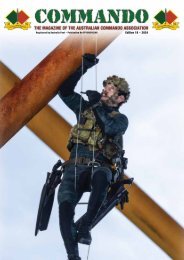Commando News Edition 13, 2022
Create successful ePaper yourself
Turn your PDF publications into a flip-book with our unique Google optimized e-Paper software.
‘Our movement was....little known’<br />
Captain Norman Roy Howard<br />
2/1 st Independent Company, AIF, Reinforcements,<br />
“I am reluctant to appear in print, but<br />
I feel obliged to do so ”. 1 With these<br />
words, Roy Howard began a letter to the<br />
editor of the Courier Mail, Brisbane, May,<br />
circa 1970, to rectify a statement pub -<br />
lished in the weeks before in which H.T.<br />
Kienzle had made the claim that he had<br />
been the first to take his troops across the<br />
Owen Stanley Ranges. He wrote not for<br />
himself but for “the officers, NCOs and<br />
men of my unit who would hope for a<br />
reply”. Typical of the man, after going into<br />
some detail of the crossing he and his unit<br />
made, he wrote: “However, in fairness to<br />
Mr Kienzle, I must state that our move -<br />
ment from Port Moresby to Wau-Lae-<br />
Salamaua was little known”.<br />
This feat of successfully leading the first<br />
army crossing over the Owen Stanley<br />
Ranges was not all that was ‘little known’.<br />
There were other ‘firsts’ during his active<br />
service and in the years following. They<br />
too are ‘little known’.<br />
***********************<br />
At the outbreak of hostilities in Europe, Norman<br />
Roy Howard was working in the Territory of New<br />
Guinea on the goldfields where he remained<br />
throughout 1940. Not long into the new year he<br />
enlisted at Rabaul. Following a successful medical<br />
examination at Salamaua on 21 February, he was<br />
dispatched along with others identified as ‘New<br />
Guinea Enlistments’, back to Australia arriving in<br />
Brisbane on 4 March, 1941.<br />
Unknown is the name of the paper that ran the story<br />
on the group, newly arrived from the Territory of New<br />
Guinea. Handwritten on the top left hand corner is<br />
‘March 1941’. Under the photograph it reads,<br />
‘Five men enlisted for the A.I.F. in New Guinea,<br />
have arrived at the Reception Depot at the Exhibition<br />
Grounds. They presented the camp commandant<br />
(Major C. (torn) S. French) right, with a (torn) drum and<br />
an war axe. Their names are (torn), J. Roche, N. R.<br />
Howard, (torn) Pearson and (torn).’ 2 Roy is the one<br />
seated on the right looking up towards the ‘drummer’.<br />
Two days after arriving at the Reception Camp Roy was<br />
sent to Redbank where the months of training began.<br />
Initially, Roy was ranked as a Private, however he<br />
quickly showed aptitude for leadership moving to<br />
Lance Corporal within the month and Corporal within<br />
the next three weeks. As with everything he undertook,<br />
Service Number NGX174<br />
Captain Norman Roy Howard<br />
NGX 174<br />
Green Double Diamonds<br />
2/1 st Independent Company<br />
AIF<br />
he applied himself diligently to his<br />
training, signalling himself out as having<br />
the capacity, the character and the<br />
commitment to undertake Officer Training.<br />
By 11 May, he had been sent to the Royal<br />
Military College, Duntroon in Canberra for<br />
an intensive course in which not all would<br />
succeed. In a letter written to Veronica<br />
Hogan, his fiancé, he explains the<br />
atmosphere before and after the Entrance<br />
Exam that took place on the Monday<br />
morning following the arrival of<br />
candidates from every State, sixty in total:<br />
‘.....During the whole weekend, all the<br />
lads were most serious, long-faced and<br />
worried. To laugh or sing sounded like<br />
sacrilege......The atmosphere is different<br />
altogether now – charged with song,<br />
laughter and merriment for we who are left<br />
are safe – for the time being anyway...........<br />
We were examined on six military<br />
subjects..... Out of the 60......52 of us<br />
passed outright of which I was one.<br />
Whoopee. I hope I’m on the list of<br />
successes when the final lists are posted at the end of<br />
the course........... It is a wonderful College here –<br />
beautiful buildings and surroundings and everything<br />
most convenient. For example, in each of our rooms<br />
there is a radiator for warmth and I might add that we<br />
need them too. It is mightily cold down here....’ 3<br />
Roy’s hope was fulfilled, his name posted on the<br />
Final List at the end of the course. He qualified gaining<br />
72% in the final exams. The Confidential Report<br />
deemed him suitable as a ‘Platoon Commander’ while<br />
noting him to be ‘a good type though appearance not<br />
impressive’! It also noted, ‘Quiet disposition. Keen and<br />
does good work.’ 4<br />
Roy was appointed to the Commissioned Reserves<br />
awaiting a posting. Following his return to Redbank, he<br />
received word on 22 August that he now held the rank<br />
of Lieutenant attached to the 2/9 Battalion. As Japan<br />
had not yet entered the war, it was assumed he would<br />
eventually be posted to Europe or the Middle East.<br />
This changed however when Pearl Harbour was<br />
bombed on 7 December, 1941. By 23 January 1942,<br />
the Japanese Navy had taken the strategically<br />
advantageous township of Rabaul on New Guinea’s<br />
northern coastline and had its sights firmly set on<br />
moving from there, across and down to Port Moresby.<br />
Roy’s specific knowledge of the area and his<br />
COMMANDO ~ The Magazine of the Australian <strong>Commando</strong> Association ~ <strong>Edition</strong> <strong>13</strong> I <strong>2022</strong> 33
















